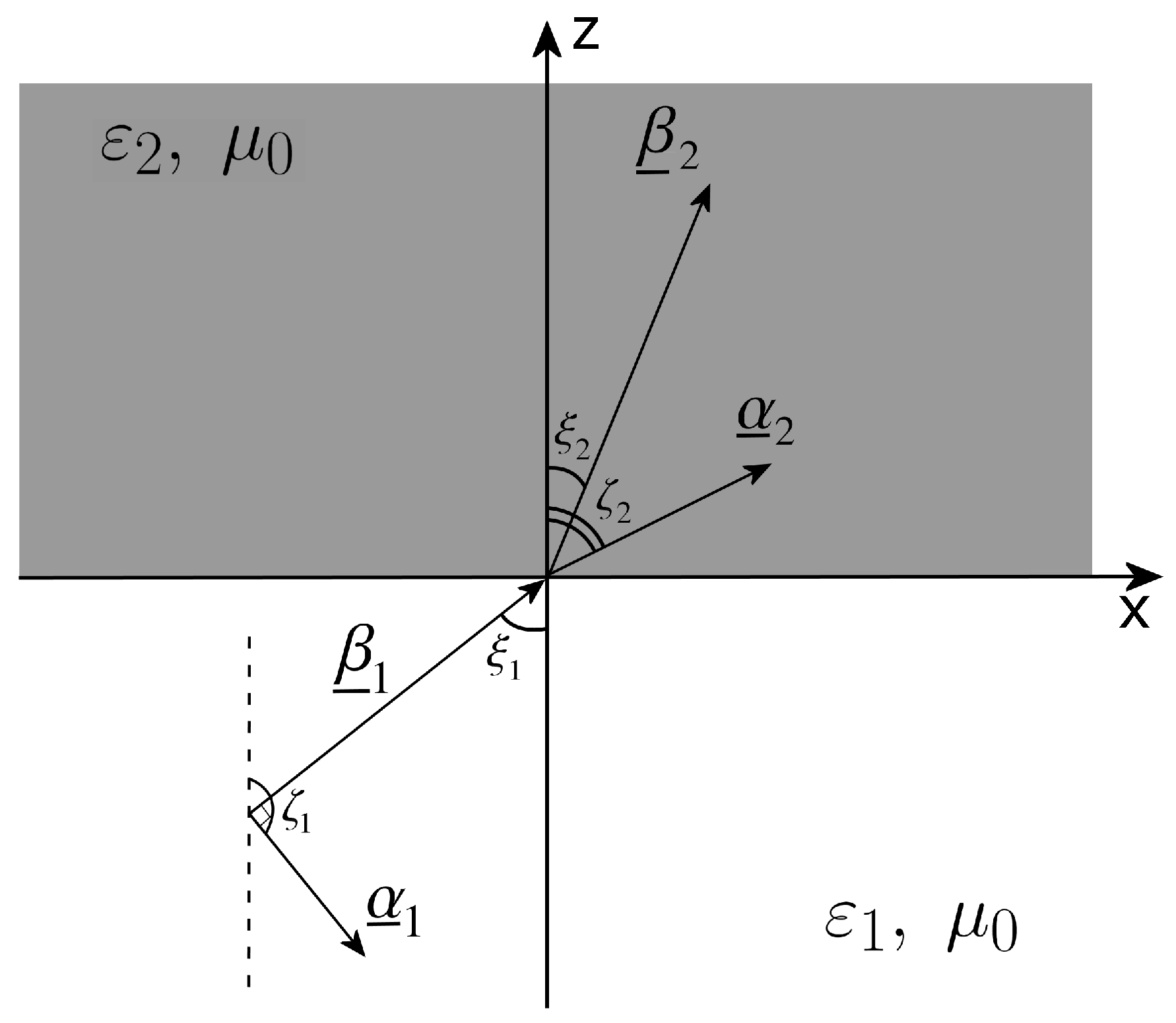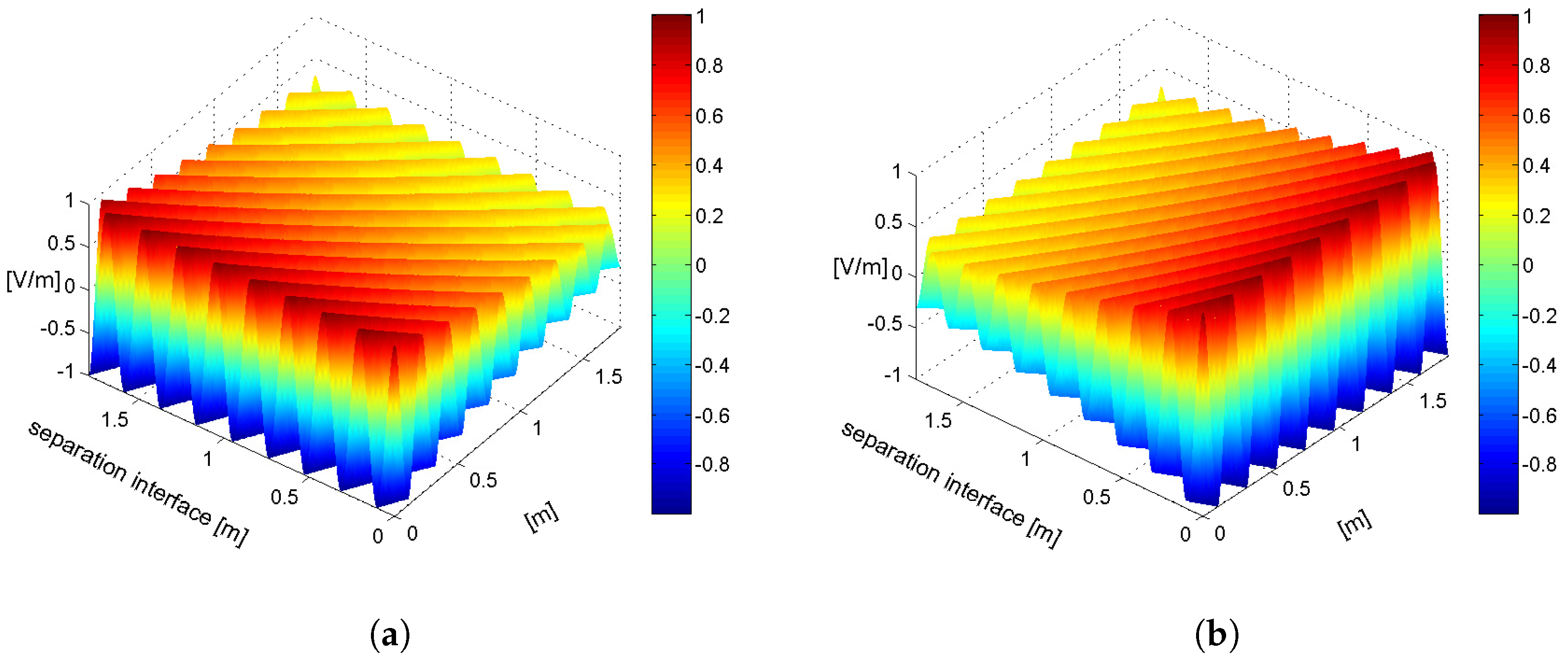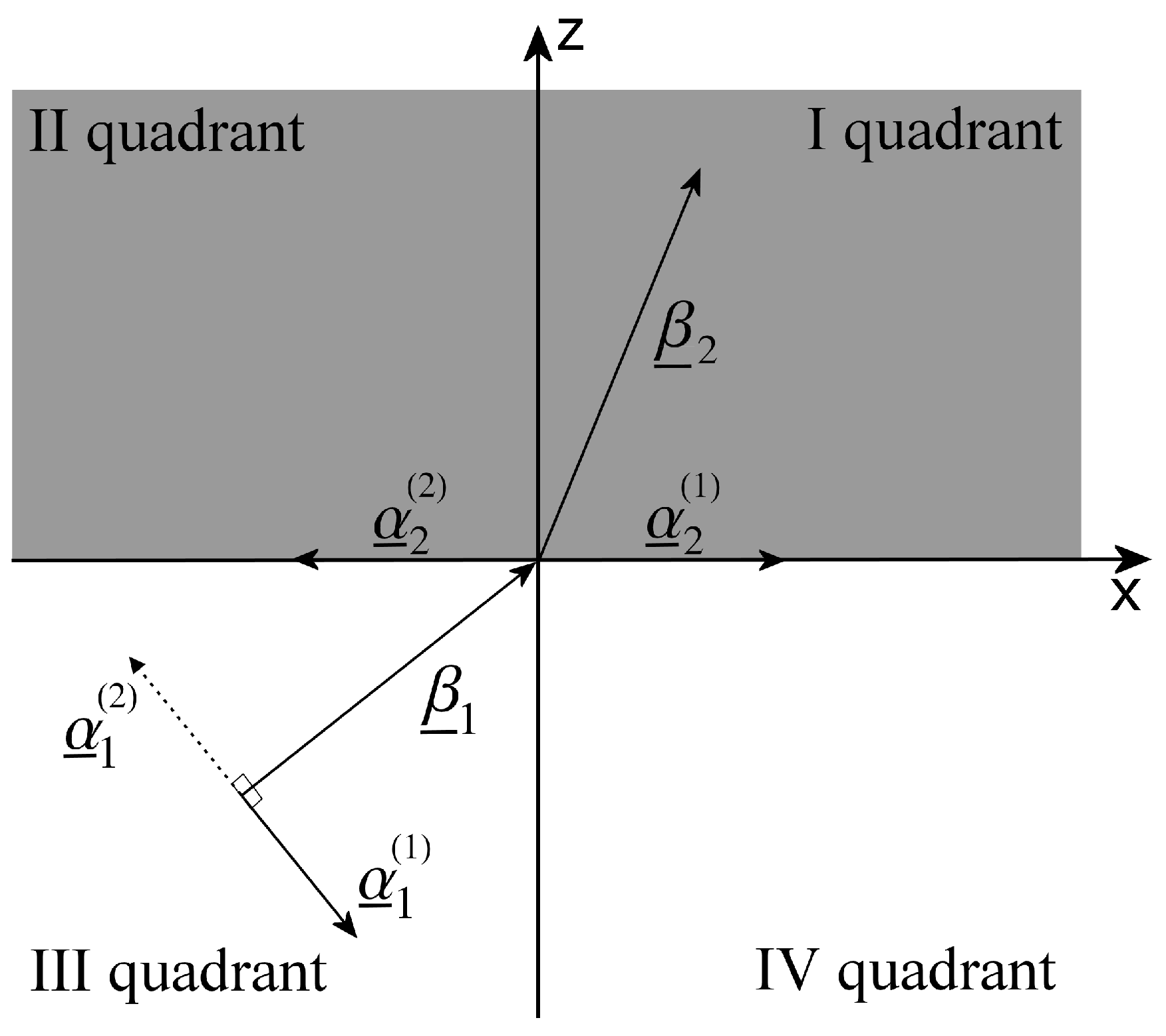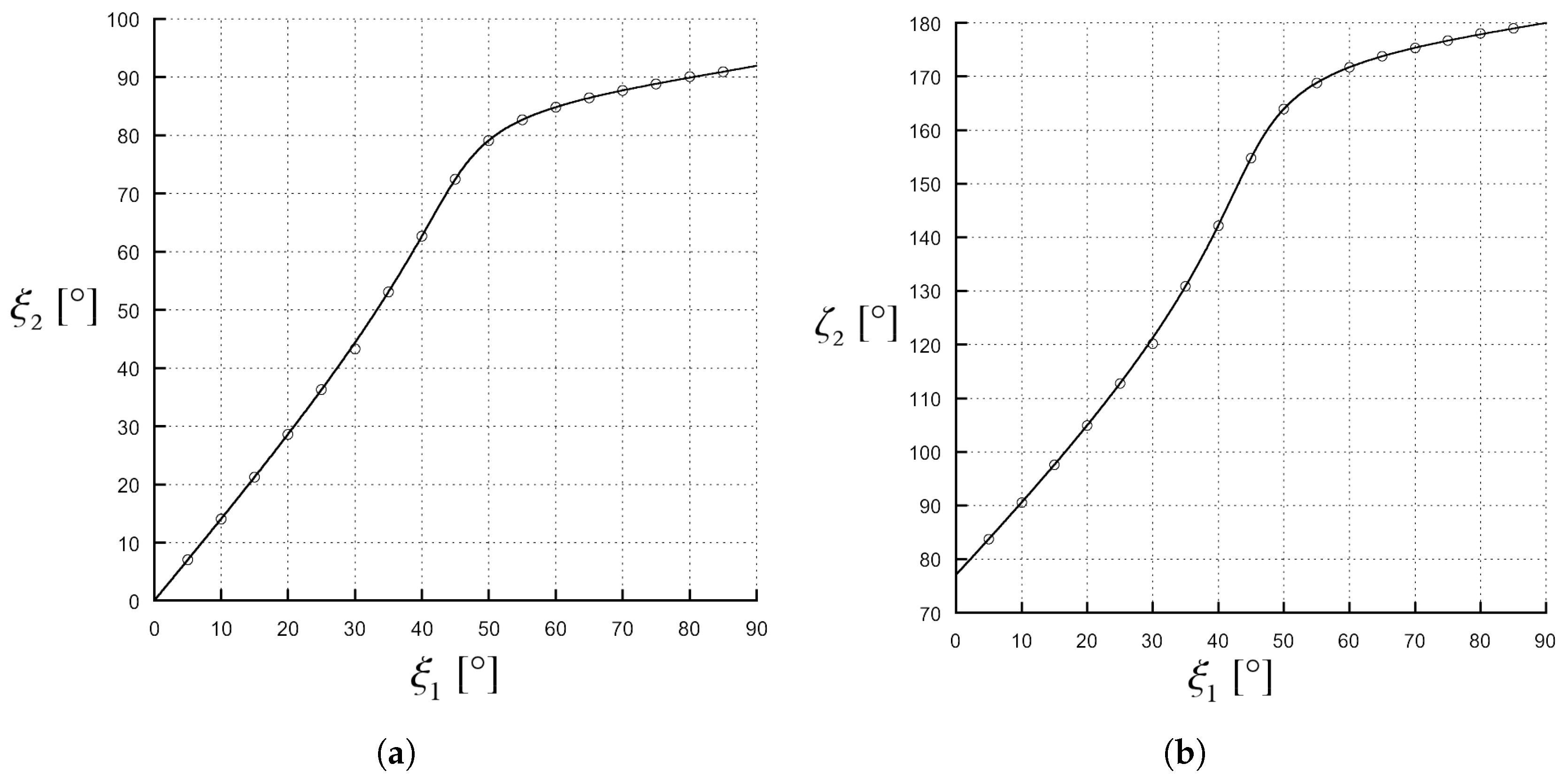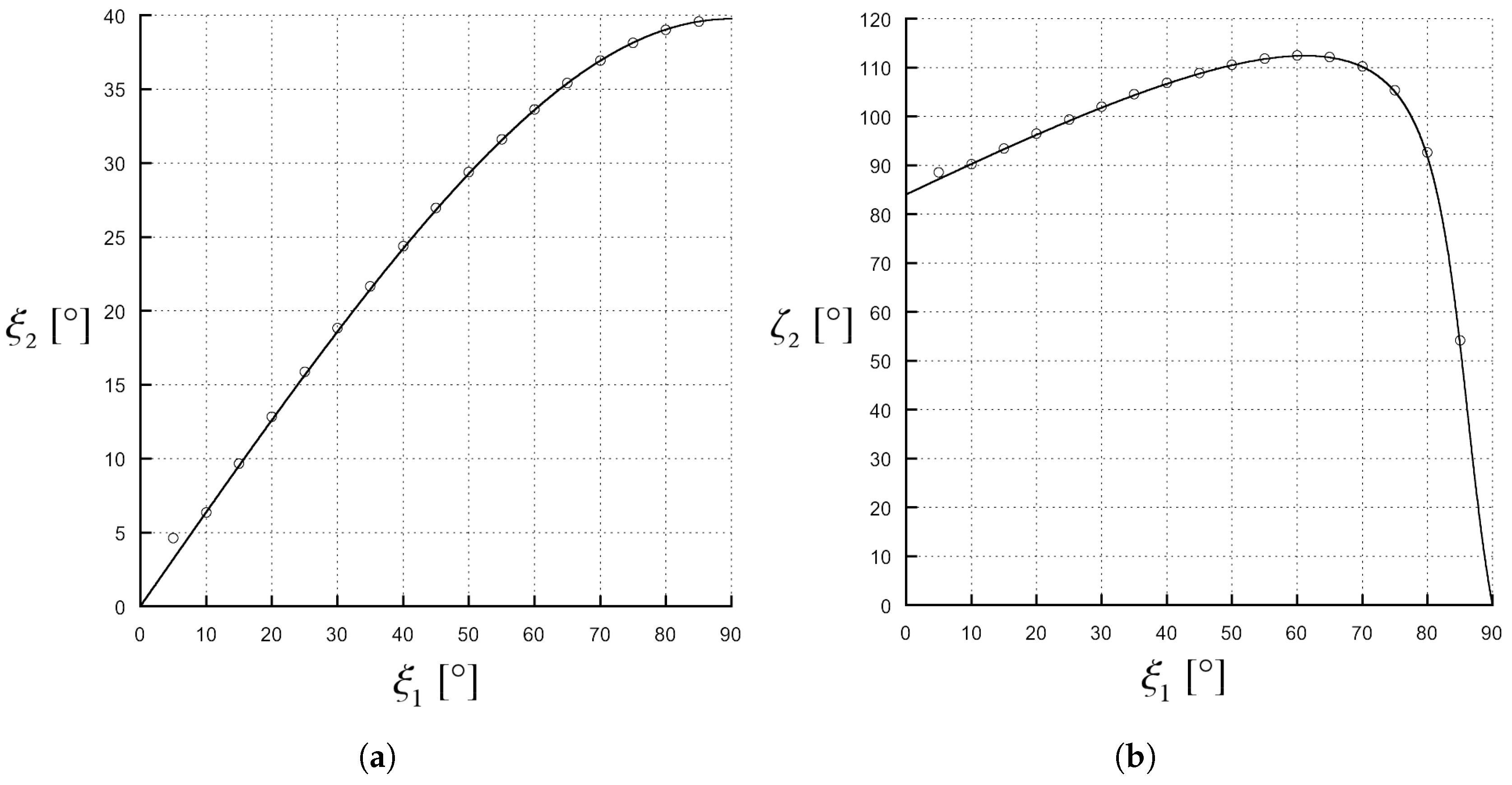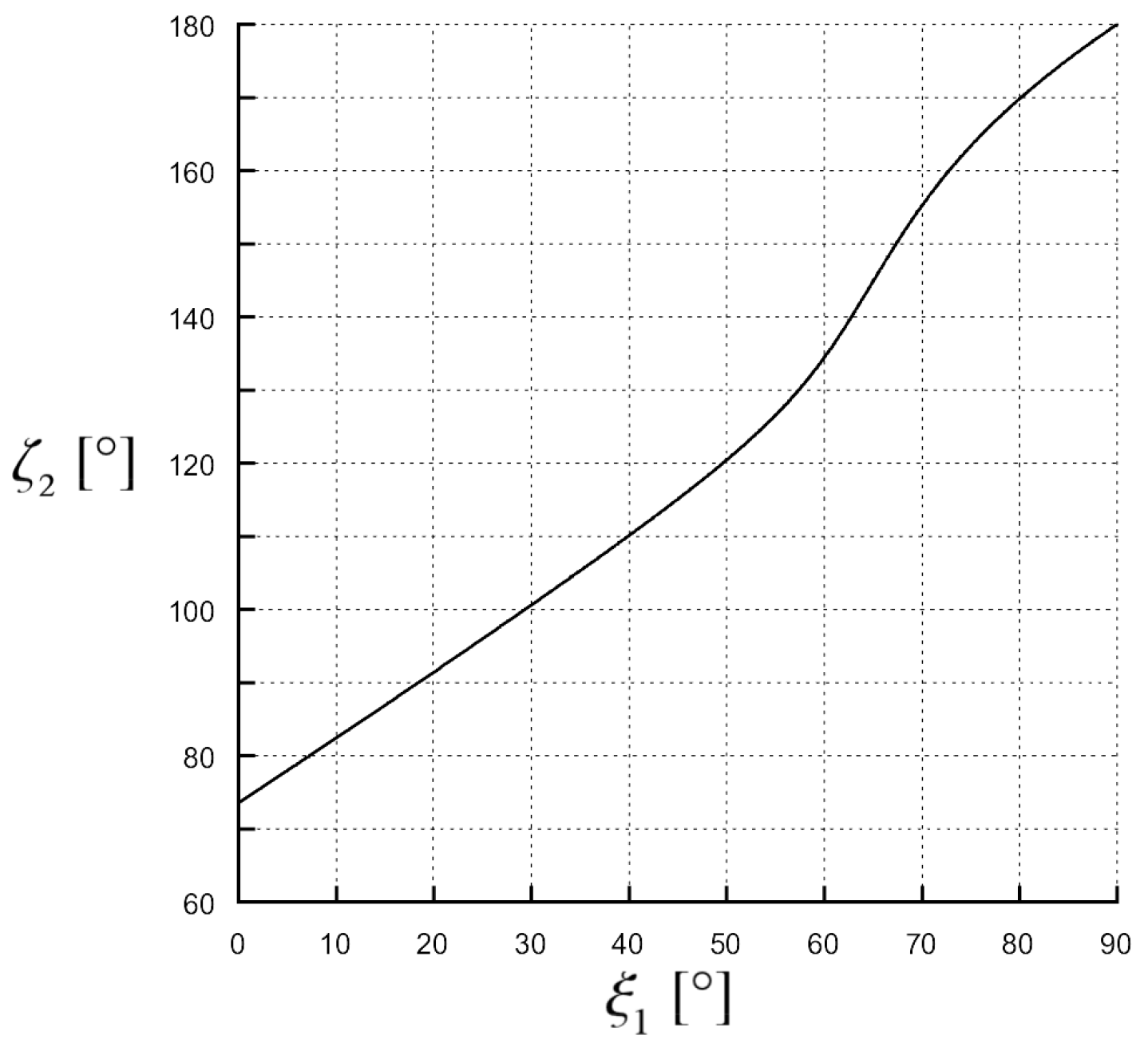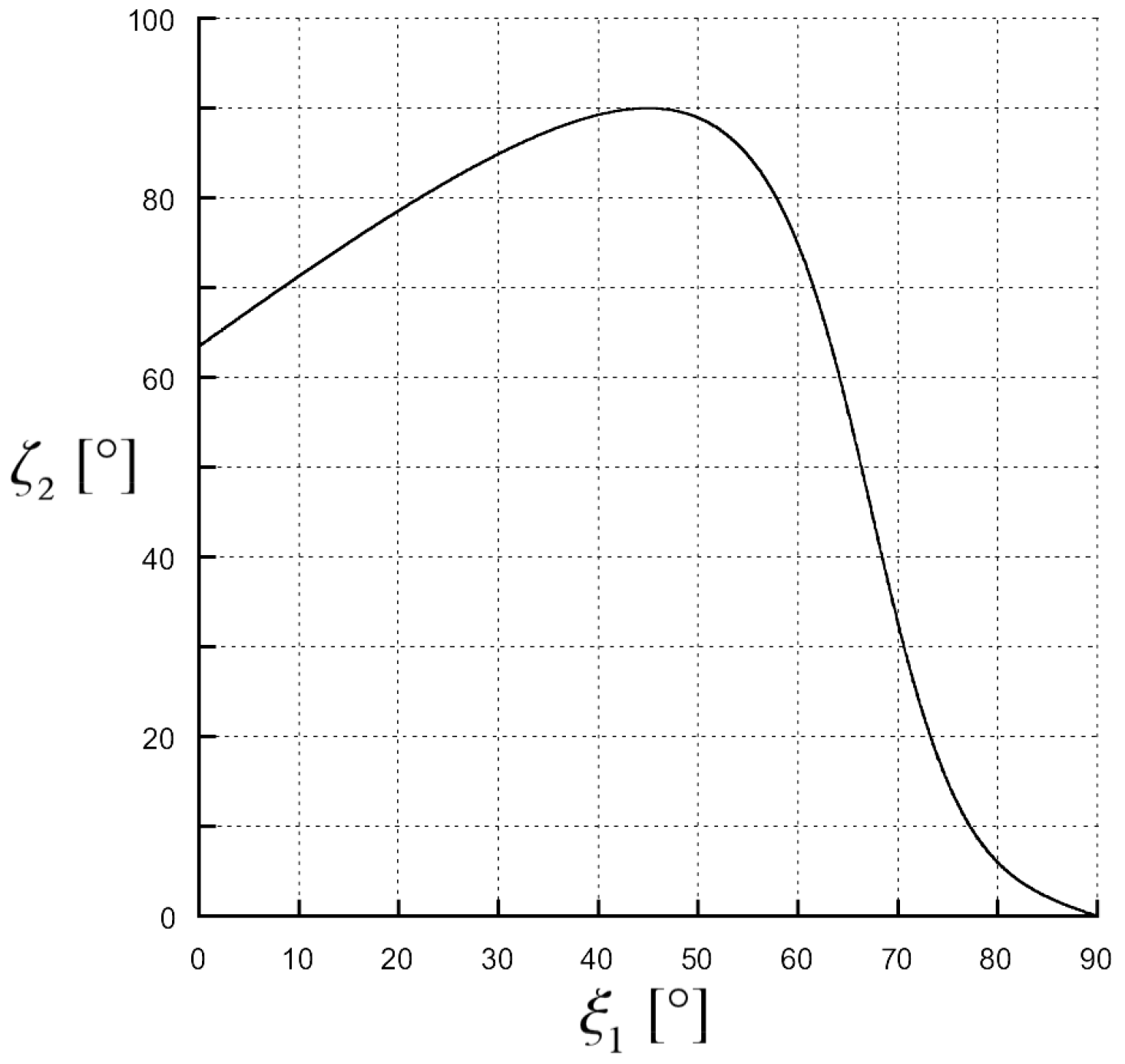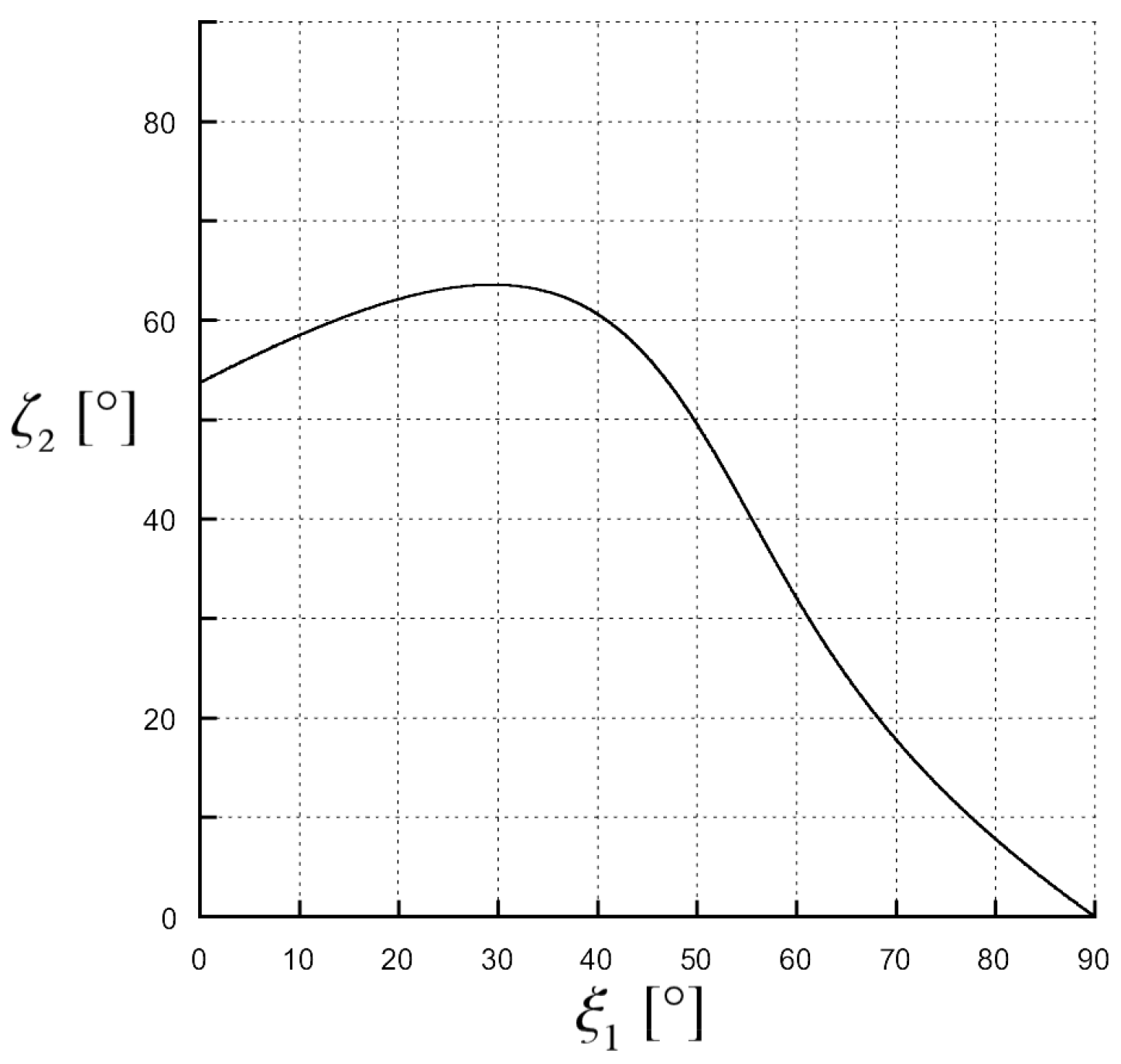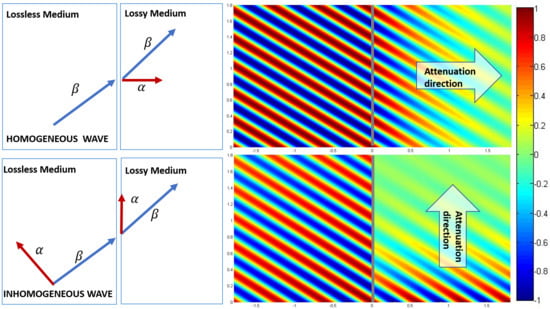3.1. The Direction of the Attenuation Vector in the Lossless Medium and Its Physical Consequences
In [
7], it is simply assumed that the deep penetration phenomenon can be obtained when
and
are orthogonal, but no hypothesis is provided around the direction of the vector
, which theoretically can form with
an angle equal to
, as shown in
Figure 3. Here, the discussion on the impact of the direction of the attenuation vector
and the relevant practical implications on how to obtain the deep penetration will be studied in detail.
The ambiguity on the sign of the angle formed by
and
corresponds to an ambiguity in the direction of the attenuation vector, as shown in
Figure 3. We are going to demonstrate that only one direction of the attenuation vector of the incident wave allows for deep penetration, and specifically the one corresponding to the angle
(see
in
Figure 3); the other solution, i.e., relevant to the angle
(see
in
Figure 3), produces, instead, an attenuated transmitted wave.
Since the incident inhomogeneous wave can admit
and
, the condition for deep penetration
translates either into
or into
, respectively, as is shown in
Figure 3. With reference to
Figure 3, the phase vector
is incoming from the III quadrant and impinges on the origin of the axes: it follows that the vector
can only be in the I quadrant due to the conservation of the tangential component of
. In the case illustrated, the angle formed by
and
must be always less than
(it is
), therefore
can never be a solution of our problem, the only valid solution is represented by
. As a consequence,
can never allow for deep penetration, but it can only admit an attenuated solution with
laying in the second quadrant (again for the conservation of tangential component); on the opposite, the solution represented by
guarantees, as predicted, a deep penetration effect, allowing
as a valid solution.
We note that the inhomogeneous wave characterized by
in the III quadrant of
Figure 3 corresponds to a field that grows in the direction normal to the separation surface (entering medium 2), while the
one to a decreasing field. Inhomogeneous waves of the former kind are also known as improper leaky waves, while those of the latter kind as proper leaky waves [
8]. Hence, we conclude that the deep penetration phenomenon can only be obtained if the impinging inhomogenous wave in the lossless medium is an improper leaky wave.
As is known, an improper leaky wave violates the Sommerfeld condition [
9], but, even though this condition is violated, such a wave can be produced by a finite source in a limited region of space. In
Figure 4, a simple ray picture of an improper leaky wave launched by a source at
along the positive
x-direction of an open waveguide is shown. The field on the aperture (
) has the form of a leaky wave, e.g., the
y-component of the electric field is
exp
, where the complex wavenumber of the leaky wave is given by
, with
and
the relevant phase and attenuation constant, respectively [
8]. The wave decays exponentially for
; however, the leaky-wave field may be dominant on the aperture out to a considerable distance from the source. In addition, the exact field due to the leaky-wave aperture distribution may be calculated by using a simple Fourier transform approach in terms of an appropriate plane-wave expansion [
8]. This interpretation is coherent with [
12], where it is demonstrated that the radiation generated can be interpreted as the sum of two components: a leaky wave and a space wave, of which the first one is more relevant close to the source while the other prevails at a large distance from the source. If the leaky wave is excited strongly, its power is transferred to the space wave and carried to the far field, and the radiation peak is obtained at an angle close to the propagation angle of that complex wave.
Rays, in
Figure 4, indicate the direction of the power flow in the air region, which for an inhomogeneous plane-wave field is in the direction of the phase vector
, i.e., at an angle
with respect to the
z-axis. The separation between the rays indicates the strength of the field. In particular, closer separation corresponds to a stronger field. A leakage “shadow boundary” exists at the angle
from the
z-axis that separates a “wedge-shaped region”, i.e.,
, where the field is similar to that of an inhomogeneous plane wave (improper leaky wave), from the region defined by
, where the field is very weak. In practice, as an observer moves vertically away from the aperture, e.g., along the red dashed line in
Figure 4, the field level will increase exponentially up to the leakage shadow boundary, and will then decrease very quickly above this boundary. Therefore, the field from this leaky wave will not increase indefinitely in the vertical direction, and will not violate the radiation condition at infinity [
12,
13]. Hence, if the lossy medium is placed in the wedge-shaped region highlighted in
Figure 4, improved penetration can suitably occur. Hence, the inhomogeneous wave is a model valid to represent physically achievable waves, as the improper leaky waves in the near field of a LWA, only in a well-defined region of the space that, in particular, can include the lossy medium, thus allowing for deep penetration.
In conclusion, a monodimensional planar LWA, operating in the improper leaky-wave regime [
8] and posed in medium 1 at a given distance from and on a plane parallel to the separation surface with the dissipative medium 2, can be suitably used to obtain deep penetration of electromagnetic field in lossy media, provided that the lossy volume is positioned in the near-field wedge-shaped region of the LWA.
LWAs promise a deep penetration effect in the near field, therefore they are suitable in all scenarios in which the penetration needs to be sustained for a limited number of wavelengths, as, for instance, it was illustrated in [
5,
6], where LWAs were found to guarantee higher penetration in biomedical applications such as hyperthermia.
3.2. Complete Set of Conditions for Deep Penetration
The complete set of solutions for Equation (
4) in the interval
is given by:
Equation (6) being the one reported in [
7]. In this section, both the expressions of
in Equations (6) and (
7) will be physically interpreted and it will be shown that the two obtained solutions may not always imply deep penetration. An accurate analysis of the two media involved will follow, in order to determine when deep penetration is practically achievable.
The first medium is supposed lossless, therefore if we consider the incident inhomogeneous wave suitable for obtaining deep penetration (i.e., see
in
Figure 3) and we apply the generalized Snell laws and the separability condition in the second lossy medium, we obtain the following Equations:
Equation (9) can be rewritten exploiting the orthogonality of the phase and attenuation vectors in the first medium. Since the angle formed by
and
is
, from
Figure 1, it follows that:
Hence, by using (9) and (12), it is:
and, introducing (8) and (13) into (11), we obtain:
If we look for the critical angle at which the transmitted attenuation vector
is parallel to the interface, we must impose
in (14), obtaining (
4). However, if we look for the critical angle at which the transmitted phase vector
is parallel to the interface, we must impose
obtaining, again, (
4). The conditions found classify two very different physical problems, the former represents deep penetration, while the latter reminds one very closely of the so-called Zenneck wave at the interface between two lossy media [
14], but it differs from the Zenneck wave for the absence of the total-transmission effect [
15]. Here, we need to distinguish the two physical problems, i.e., we must find a way to understand when a transmitted phase or attenuation vector parallel to the interface can be obtained, respectively. To ascertain such a condition, we can consider the expressions of the magnitudes of the transmitted phase and attenuation vectors in medium 2 given in [
16]
where
indicates the component of
parallel to the separation interface.
Let us consider the absolute value under square root: hence, by using (
4), i.e., under the hypothesis that
or
, we can find the following expression:
Substituting (17) in (15) and (16), we found that the solution , corresponding to the transmitted phase vector parallel to the interface, is consistent with , while , corresponding to the transmitted attenuation vector parallel to the interface, requires .
It is now important to understand when the two solutions (6) and (
7) are relevant either to the case
or
. For the sake of brevity, we will call the solution of the “phase” type when it is relevant to the case
and of the “attenuation” type when it is relevant to the case
(i.e., the deep penetration case).
Let us impose the phase type solution,
in (17), it follows
. Then, by applying bisection-trigonometrical formulas, it is:
Furthermore, defining the quantity
as follows:
Equation (18) can be written as:
Using the two conditions of Equations (6) and (
7), (20) can be written in terms of
, so
is of the phase type when
, otherwise it is of the attenuation type;
is of the phase type if
, otherwise it is of the attenuation type. From such conditions, it is possible to foresee the type of the solutions in many cases, in fact (recalling that
): if
, both
and
solutions are of the phase type; if
, the
type is determined by the value of
, while
is of the phase type; if
,
is of the attenuation type, while
is of the phase type; if
,
is of the attenuation type, while the
type is determined by the value of
; finally, if
, both the solutions are of the attenuation type.
Important physical constraints for the media involved in the deep penetration phenomenon can be derived by the previous analysis. Looking at the expression (19), we see that the sign of
is determined by the ratio of the real parts of the permittivities (note that both medium 1 and medium 2 are assumed non-magnetic). The case in which both the solutions are of the phase type (i.e.,
) requires
: this case, which is not uncommon at the optic frequencies (e.g., gold and silver exhibit
values at such frequencies), is not probable at microwave frequencies; therefore, we can say that, in the case of microwave radiation, adopted in many applications, a deep penetration solution always exists, while for different frequency ranges may not be guaranteed. Furthermore, we observe that
when
. In this scenario, that is typically met, e.g., the case of incidence from a vacuum, the solution
is always of the attenuation type. The behavior of
depends on the characteristics of the incident wave and in particular on the parameter
: in fact, the quantity in brackets in (19) is multiplied by a function of such parameter that is a decreasing function bounded in the interval
. As a consequence, the larger
is, the smaller
is, making the determination of the type of
dependent on
even for a high
ratio. Numerical results are shown in
Figure 5 and
Figure 6 for the cases
and
, respectively. The angles have been computed both with a numerical code in Matlab, implementing the analytical expressions of
and
as a function of
obtained from Equations (8) and (9), and with full-wave simulations on Comsol Multiphysics [
17] (COMSOL Inc., Version 5.3 ), a commercial software based on the Finite-Element Method. In
Figure 5, a medium 1, with
, and a medium 2, with
and
, are considered, the phase vector of the incident wave is
.
as a function of
is illustrated in
Figure 5a: the only solution of phase type appears when
. In
Figure 5b,
as a function of
is shown: the only solution of attenuation type appears for
and after this value
keeps incrementing for higher
values. As a consequence, we observe a wave with
and a negative normal component of the attenuation vector in medium 2. Finally, comparing
Figure 5a with
Figure 5b, it can be seen that
grows when
also is increasing; this means that
vector tends to be parallel to the separation surface when the penetration gets stronger: the combined effects of the two vectors should therefore be considered in practical applications. Moreover, in
Figure 5a, we can note that, for an amplitude of
larger than
, the transmitted phase vector angle,
, assumes values larger than
, i.e., the transmitted phase vector is directed backwards in the half-space of origin of the incident wave; it is important to emphasize that this behaviour does not mean that the energy flow follows such a direction: in fact, when an inhomogeneous wave in a dissipative medium is considered, the direction of the energy flow is not the one of the phase vector, as well explained in [
10,
18].
In
Figure 6, a typical scenario is shown instead in which both solutions are of attenuation type, i.e.,
: in this case, it is
,
,
, and
. It can be noticed that the transmitted phase vector is never parallel to the interface (see
Figure 6a) while the transmitted attenuation vector is parallel to the separation interface for two values of the incidence angle: namely,
and
(see
Figure 6b). Also in this second scenario, similarly to what occurs for
(see
Figure 5), there is a region in which
assumes values larger than
.
3.3. Electromagnetic Penetration around the Deep Penetration Condition
The minimal condition that allows for deep penetration is guaranteed by the angle
. A stronger penetration can be achieved if the condition:
is satisfied: this condition, as said, was already found in the case of incidence from lossy medium in [
16], and it is also satisfied for some incident angles in
Figure 5b and
Figure 6b, when the first medium is lossless.
In the conventional scenario in which the propagating wave attenuates entering in the lossy medium (), the components typical to the separation surface of both and have the same sign, while (21) shows a case in which those two components must present opposite signs: this means that the field increases while propagating in the lossy medium. We are going to demonstrate that the condition of (21) can be obtained by studying the case in which both the incident wave (and in particular its operating frequency and incident angle ) and medium 1 are maintained constant, while the lossy medium 2 is varied in its value. This in turn is equivalent to consider an inhomogeneous plane wave designed to impinge on a separation surface with a lossy medium 2 characterised by a relative permittivity , so that assumes the critical value ; then, such a wave is applied, with the same incidence angle, to an interface with a lossy medium for which . We note that this scenario has practical applicability because it describes the common case in which an antenna design is performed and then the antenna is exposed to a medium which does not fully match the one for which the structure was optimised.
Let us now assume that we met the condition of (
3) for
, so that
=
. Let us now decrease the imaginary part
of
to a positive value smaller than
. This new value of the imaginary relative permittivity implies different amplitudes and directions for the transmitted phase and attenuation vectors; let us call with
and
the magnitudes of such vectors and with
and
the new angles formed by those vectors with the normal to the separation surface, respectively. Consequently, the new wave vector in medium 2 is indicated with
and the wave number with
. From (11), having imposed
(i.e.,
), it follows that:
where (22) can be rewritten as follows:
We considered the hypothesis in which the same wave incoming from a lossless material was applied to two different media with the same incident angle; therefore, using (8) and (13), the following system of Equations is obtained:
Removing
and
from (24), we have:
Now,
and
in (23) can be eliminated, finally having:
Simplifying the expression above, the following is obtained:
With reference to
Figure 3, from (26), it follows that
and
need to be positioned one on the I quadrant and the other on the IV quadrant, and in particular they cannot both be in theI quadrant; the latter would be the solution for an attenuated transmitted wave. Moreover, no assumption was made on
, apart from the deep penetration condition that forces
to be in the first quadrant, while it was posed
. Hence, it follows that it must be
because the attenuation vector
needs to be positioned to the right of
, according to the previous discussion (see
Figure 3), in order to allow for deep penetration.
Considering
would have caused, on the contrary,
and
both in theI or both in the IV quadrant: in particular, the continuity of the solution would have requested
, so both
and
lie in the first quadrant. This solution corresponds to pure attenuation of the transmitted wave in medium 2. This theoretical expansion permits us to state that, finding a
value for which (
3) is satisfied (i.e.,
), the deep penetration effect stops occurring (i.e.,
) for higher
values, while the wave penetrates in medium 2 with an increasing electric field module for lower
values (i.e.,
), thus giving rise to a deeper penetration effect.
This could state e.g., that, in any case, a lossy medium will attenuate the exponential increase of the field intensity of an improper leaky wave to a certain degree. In case the deep penetration condition is met precisely, the exponential increase is completely compensated and the resulting behaviour is a constant intensity. If the losses in the medium are larger than expected, the exponential increase is overcompensated resulting in an exponential decay. If the losses are lower, there is still an exponential increase but with a reduced rate.
Numerical results, produced by a code in Matlab implementing the analytical expressions of
and
as a function of
obtained from Equations (8) and (9), are shown in
Figure 7,
Figure 8 and
Figure 9 to prove the theory just explained. Let us assume a
wavelength, the medium 1 is a vacuum, designing
to meet the condition
when the second medium has
and
with an angle
. In
Figure 7, the transmitted attenuation angle in the case the second medium has
is shown. We can see that, in this case of increasing the incident angle, the transmitted attenuation angle reaches values greater than
, i.e., with reference to
Figure 3, the transmitted attenuation vector lies in the IV quadrant. On the other hand, in
Figure 8, the case
is considered. Here, we can see that the transmitted attenuation angle reaches the value
at the critical incident angle
, and it decreases after this maximum value. With reference to
Figure 3, it means that the transmitted attenuation vector can never lie in the IV quadrant, but it is parallel to the interface when the incident angle is equal to its critical value. Finally, in
Figure 9, the case
is considered. In this case, the transmitted attenuation angle cannot reach the value
, and it always remains less than such a value. With reference to
Figure 3, it means that the transmitted attenuation vector always lies in the I quadrant.
